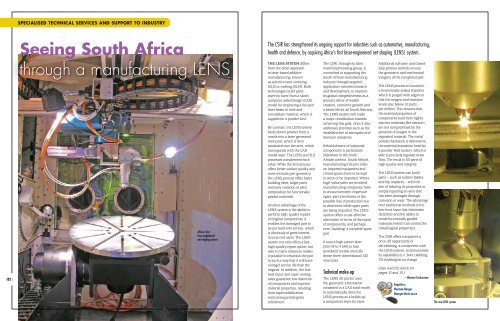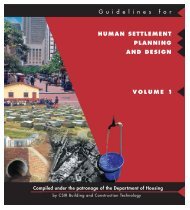SPECIALISED TECHNICAL SERVICES AND SUPPORT TO INDUSTRY| 80 |A demonstration of how an infrared imaging camera can beused to detect heat leakage <strong>and</strong> hot spots in energy-intensivesystems. Energy remains a critical resource <strong>for</strong> South Africa<strong>and</strong> an industrial energy-efficiency project was introduced in2010 in a drive to improve energy usage practices.Resource efficiency <strong>and</strong> cleanerproduction <strong>for</strong> advanced manufacturingWith current trends in global economic growth as well as population growth, environmental degradation is on the increase withboth waste <strong>and</strong> pollutants being released faster than the Earth can absorb them, <strong>and</strong> natural resources being consumed fasterthan they can be restored. New innovative patterns have emerged to reduce environmental stress <strong>and</strong> the National CleanerProduction Centre of South Africa (NCPC-SA), through its resource efficiency <strong>and</strong> cleaner production (RECP) assessment process,recommends clean production technology as a cost-saving option, in addition to other low-cost, no-cost options.The target is to drasticallyreduce the environmentalfootprint <strong>and</strong> increase thecompetitiveness of <strong>industry</strong> by‘doing more <strong>for</strong> less’.<strong>Advanced</strong> manufacturinginvolves, among other things,the introduction of new ormore efficient technologies,as well as the generation <strong>and</strong>management of knowledge.RECP is one of the very latestmethodologies aimed atimproving productivity <strong>and</strong>optimising plant operations.It focuses on improvingresource <strong>and</strong> energy efficiencyby introducing more efficienttechnologies <strong>and</strong> enablingsolutions along the value chain,thus supporting long-termsustainability in terms of globalcompetitiveness, ecology <strong>and</strong>employment.The NCPC-SA is a key industrialsustainability programme ofthe Department of Trade <strong>and</strong>Industry (the dti). Hosted by the<strong>CSIR</strong>, it utilises RECP to addressthe country’s critical need toincrease global competitiveness,while reducing resource <strong>and</strong>energy inefficiency <strong>and</strong> theenvironmental impact ofindustrial activities. In-plantassessments are undertakenat participating companies toidentify areas <strong>for</strong> efficiencyimprovement in terms of energy,water <strong>and</strong> raw material usage.“The activities of the NCPC-SAare aimed at strengtheningmarket access <strong>for</strong> South Africa’s<strong>industry</strong>, fostering networks<strong>and</strong> transferring RECPtechnologies <strong>and</strong> services;contributing to the sustainabilityof <strong>industry</strong> value chains, <strong>and</strong>delivering measurableeconomic, environmental <strong>and</strong>social impacts,” explainsNCPC-SA Director NdivhuhoRaphulu. A total of 162 cleanerproduction assessments wereundertaken between 2009<strong>and</strong> 2011, yielding potentialsavings of approximatelyR78 million. Besides thefinancial, environmental<strong>and</strong> technical benefits, amore consistent productoutput quality was alsoachieved, while the workingenvironment in participatingplants improved substantially.The services of the NCPC-SAare fully subsidised at thisstage, <strong>and</strong> are made availableto participating companiesat little or no cost, to enable<strong>industry</strong> to proactively complywith competitiveness <strong>and</strong>efficiency policy, as well asregulatory frameworks <strong>and</strong>st<strong>and</strong>ards be<strong>for</strong>e these becomelegislated.The centre currently focuses oneight priority sectors identifiedin government’s IndustrialPolicy Action Plan <strong>for</strong> 2010to 2013 (IPAP2) as key to jobcreation, economic growth<strong>and</strong> market competitiveness:Agro-processing; automotives;chemicals, plastic fabrication,cosmetics <strong>and</strong> pharmaceuticals;fibres, textiles <strong>and</strong> clothing;pulp <strong>and</strong> paper; hospitality <strong>and</strong>tourism; <strong>and</strong> metals, <strong>and</strong> capital<strong>and</strong> transport equipment. It alsoaddresses the green industriessector, which includes wasterecycling/remanufacturing <strong>and</strong>commercial buildings.Energy efficiencyEnergy remains a criticalresource <strong>for</strong> the country. Theindustrial energy-efficiencyimprovement project wasintroduced in 2010 to contributeto the sustainable trans<strong>for</strong>mationof energy usage practices inSouth African industries, <strong>and</strong>enhance national energy security,while promoting job creation<strong>and</strong> reducing carbon dioxideemissions. The project seeksto actively involve a numberof key industries identified <strong>for</strong>their potential to bring aboutsignificant reductions in theoverall energy consumption ofthe country. The first seven of anenvisaged 25 leading mediumto large companies are currentlypioneering the implementationof energy management systemswithin their operations as ameans of increasing profitability.A further participationoption involves becoming ademonstration plant where themeasurable <strong>and</strong> verifiable impactof recommended energy systemsoptimisation interventions maybe showcased. The focus is onenergy-intensive systems such assteam, compressed air, pumps,motors, process heating <strong>and</strong> fans.The project is a collaborativeinitiative between the dti <strong>and</strong>the Department of Energy, theSwiss Secretariat <strong>for</strong> EconomicAffairs <strong>and</strong> the United KingdomDepartment <strong>for</strong> InternationalDevelopment. The UnitedNations Industrial DevelopmentOrganization (UNIDO) is theimplementing agent.Small, medium <strong>and</strong> microenterprises (SMMEs) in themanufacturing sector alsobenefit from the project throughsubsidised energy audits aimedat raising awareness of thebenefits of energy-efficiencypractices.Capacity buildingThe availability of suitablyskilled human resources isessential to the implementation<strong>and</strong> sustainability of RECPmethodologies <strong>and</strong> techniquesin <strong>industry</strong>. To address thisneed, the centre facilitatesthe presentation of trainingworkshops by internationallyacknowledged experts<strong>for</strong> representatives of theenvironmental goods <strong>and</strong>services sector, as well as from<strong>industry</strong> <strong>and</strong> governmentinstitutions. RECP trainingworkshops are presented acrossthe country at least once ayear, while more than 1 000consultants <strong>and</strong> representativesof companies <strong>and</strong> governmenthave undergone variouslevels of training in the areasof energy managementsystems <strong>and</strong> energy systemsoptimisation since August 2010.The NCPC-SA also runs asustainable entrepreneurshipprogramme involving theplacement of postgraduatestudents in companies. Thesecompanies benefit fromthe availability of trained<strong>and</strong> dedicated resources inaddressing specific competitivegaps <strong>and</strong>/or environmentalconstraints, while students gainvaluable cleaner-productionexperience in the workplace.During the past year, thecentre introduced a cleantechnology acceleratorprogramme <strong>for</strong> SMMEs <strong>and</strong>entrepreneurs to leverage new<strong>and</strong> innovative technologies,with particular emphasis onenergy efficiency, renewableenergy <strong>and</strong> green buildings.The objective is to stimulategreen entrepreneurship, createmore jobs, <strong>and</strong> contributeto the sustainability of neweco-efficient enterprises. Thefirst round of winners wasannounced at a gala event inDurban during COP17.Barriers to implementationFinancial considerations <strong>and</strong>the local availability of relevanttechnologies are key barrierspreventing full implementationof RECP recommendations,“Greener productionmethodologies <strong>and</strong>technologies have a direct<strong>and</strong> positive impact on thebottom line of a company.”– Ndivhuho Raphulu, Director: NCPC-SAwhich is required to maximisethe cost-savings benefitsof RECP. To address this,government is finalising asuite of incentive schemes,which companies that adoptcleaner production as atool to improve efficiency<strong>and</strong> competitiveness canapply <strong>for</strong>. This includes a taxrebate, a scheme to supportthe implementation ofenergy-efficiency measures,<strong>and</strong> the soon-to-beannouncedmanufacturingcompetitiveness enhancementprogramme (MECP) of the dti.Enquiries:Petro de Wetpdewet@csir.co.zaCapacity building is a key focus of the industrial energy-efficiency project. Training workshopson energy management systems <strong>and</strong> energy systems optimisation – ranging from pumps to fansystems – are presented by international experts at advanced user <strong>and</strong> expert level. Pictured isthe first South African group of expert-level trainees on fan systems during the on-site practicalsession at SAB Maltings. From left are USA-based trainer Ron Wroblewski; Alfred Hartzenburg,NCPC-SA; Erik Kiderlen, Ashway Investments CC; Bill Cory, UNIDO; Eddie Raad, CFW Fans;Hamied Mazema, UNIDO; Azeem Mohamood, Saint-Gobain Construction; Jaco Kirstein, SAB Ltd;<strong>and</strong> Darrin McComb, Resource Innovations.| 81 |
SPECIALISED TECHNICAL SERVICES AND SUPPORT TO INDUSTRYSeeing South AfricaThe <strong>CSIR</strong> has strengthened its ongoing support <strong>for</strong> industries such as automotive, manufacturing,health <strong>and</strong> defence, by acquiring Africa’s first laser-engineered net shaping (LENS) system.| 82 |through a manufacturing LENSAfrica’s firstlaser-engineerednet-shaping systemThe LENS system differsfrom the other approachto laser-based additivemanufacturing, knownas selective laser sintering(SLS) or melting (SLM). Bothtechnologies build partslayer-by-layer from a slicedcomputer-aided design (CAD)model by employing a focusedlaser beam to melt <strong>and</strong>consolidate material, which issupplied in a powder bed.By contrast, the LENS systemfeeds blown powder from anozzle into a laser-generatedmelt pool, which is thentranslated over the area, whichcorresponds with the CADmodel layer. The LENS <strong>and</strong> SLSprocesses complement eachother. While the SLS processoffers better surface quality <strong>and</strong>more intricate part geometry,the LENS process offers fasterbuilding rates, larger parts<strong>and</strong> easy variation of alloycomposition <strong>for</strong> functionallygraded materials.Another advantage of theLENS system is the ability toper<strong>for</strong>m high-quality repairsof original components; itenables the damaged part tobe put back into service, whichis obviously of great interestto local end users. The LENSsystem not only offers a fast,high-quality repair option, butalso in many instances makesit possible to refurbish the partin such a way that it will havea longer service life than theoriginal. In addition, the lowheatinput <strong>and</strong> rapid-coolingrates guarantee low distortionof components <strong>and</strong> superiormaterial properties, resultingfrom rapid solidification<strong>and</strong> consequential grainrefinement.The <strong>CSIR</strong>, through its lasermaterial processing group, iscommitted to supporting theSouth African manufacturing<strong>industry</strong> through targeted,application-oriented research<strong>and</strong> <strong>development</strong>, to improveits global competitiveness as aprimary driver of wealthcreation, economic growth <strong>and</strong>a better life <strong>for</strong> all South Africans.The LENS system will makea major contribution towardsachieving this goal, since it alsoaddresses priorities such as theestablishment of aerospace <strong>and</strong>titanium industries.Refurbishment of industrialcomponents is particularlyimportant in the SouthAfrican context. South Africa’smanufacturing <strong>industry</strong> relieson imported equipment <strong>and</strong>critical spares have to be keptin stock or be imported. Wherehigh-value parts are involved,manufacturing companies haveto choose between expensivespare-part inventories or thepossible loss of production dueto downtime while spare partsare being imported. The LENSsystem offers a cost-effectivealternative in terms of the repairof components, <strong>and</strong> perhapseven ‘building’ a complete sparepart.It uses a high-power laser(500 W to 4 kW) to fusepowdered metals into fullydense three-dimensional (3D)structures.Technical make-upThe LENS 3D printer usesthe geometric in<strong>for</strong>mationcontained in a CAD solid modelto automatically drive theLENS process as it builds upa component layer-by-layer.Additional software <strong>and</strong> closedloopprocess controls ensurethe geometric <strong>and</strong> mechanicalintegrity of the completed part.The LENS process is housed ina hermetically sealed chamberwhich is purged with argon sothat the oxygen <strong>and</strong> moisturelevels stay below 10 partsper million. This ensures thatthe material properties ofcomponents built from highlyreactive materials like titaniumare not compromised by thepresence of oxygen in thedeposited material. The metalpowder feedstock is delivered tothe material deposition head bya powder-feed system, which isable to precisely regulate massflow. The result is 3D parts ofhigh quality <strong>and</strong> integrity.The LENS system can buildparts – such as turbine blades<strong>and</strong> hip implants – with theaim of tailoring its properties orsimply repairing an area thathas been damaged throughcorrosion or wear. The advantageover traditional methods is thelow-heat input that eliminatesdistortion <strong>and</strong> the ability tocreate functionally gradedmaterials (which can control themetallurgical properties).The <strong>CSIR</strong> offers companies aonce-off opportunity ofrefurbishing a component withthe LENS system, to demonstrateits capabilities (i.e. bore cladding,3D cladding) at no charge.(Also read the article onpages 12 <strong>and</strong> 13.)– Mzimasi GcukumanaEnquiries:Herman Burgerhburger@csir.co.zaThe new LENS system| 83 |
















